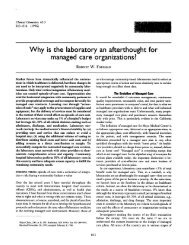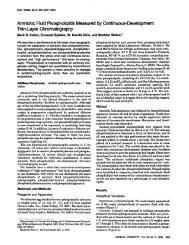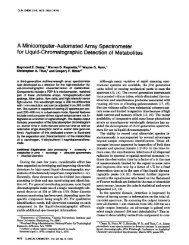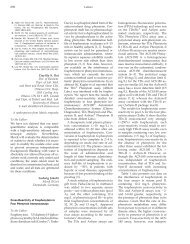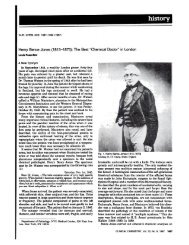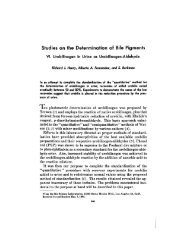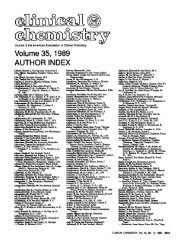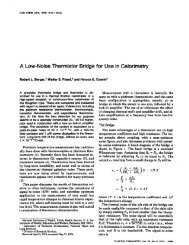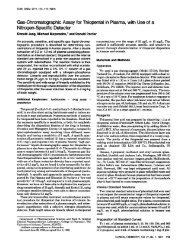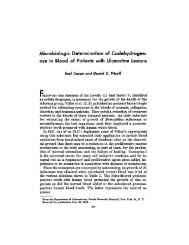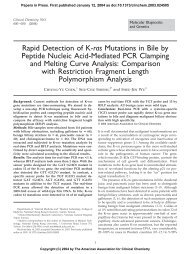Coagulation Cascade: A Series of Limericks - Clinical Chemistry
Coagulation Cascade: A Series of Limericks - Clinical Chemistry
Coagulation Cascade: A Series of Limericks - Clinical Chemistry
You also want an ePaper? Increase the reach of your titles
YUMPU automatically turns print PDFs into web optimized ePapers that Google loves.
<strong>Coagulation</strong> <strong>Cascade</strong>: A <strong>Series</strong> <strong>of</strong> <strong>Limericks</strong><br />
Mark A. Vande Haar and Karyn A. Fay*<br />
Intrinsic:<br />
Hageman factor 1 with contact from collagen<br />
can be sufficient to convert the zymogen.<br />
Fitzgerald’s 2 not needed,<br />
but <strong>of</strong>ten has speeded<br />
the addition <strong>of</strong> “a” to XI.<br />
When your body’s subjected to contusing,<br />
factor XI can help stop the bruising.<br />
With calcium’s aid,<br />
factor IXa 3 is made,<br />
and from here on it gets more confusing.<br />
You may think all this stuff is insipid,<br />
but with calcium, VIIIa, and some phospholipids, 4<br />
tenase is formed<br />
as per the norm,<br />
and at prothrombinase, 5 intrinsic has ended.<br />
Extrinsic:<br />
If you’re dying from a traumatic hemorrhage,<br />
your body can make its own bandage.<br />
Factor III is released,<br />
and calcium completes<br />
the VIIa 6 and TF 7 assemblage.<br />
Common:<br />
The common pathway’s where it all comes together<br />
and saves you from the brink <strong>of</strong> the nether.<br />
Factors X, V 8 , and IV 9<br />
put their foot in the door<br />
and then thrombin 10 starts building the anchor.<br />
This one can be a tough customer:<br />
factor II 11 converts I 12 to a monomer.<br />
Factors V and VIII swoop<br />
in positive feedback loops 13<br />
and XIIIa 14 transmutes fibrin polymer.<br />
Unveiling the Right Side<br />
<strong>Clinical</strong> <strong>Chemistry</strong> 56:8 (2010) 1369
Fibrinolysis:<br />
Lysis is launched by tissue plasminogen activator. 15<br />
This enzyme causes serine to splinter.<br />
Now plasmin’s 16 adrift<br />
inciting a rift,<br />
and D fragments can bind with twin sisters. 17<br />
Interactions:<br />
Factor VIII 18 and von Willebrand’s factor stick,<br />
and with platelets they help “make blood thick.”<br />
This starts the plug<br />
and it makes me quite smug<br />
to know I won’t die from this prick.<br />
Regulation:<br />
Author Contributions: All authors confirmed they have contributed to<br />
the intellectual content <strong>of</strong> this paper and have met the following 3 requirements:<br />
(a) significant contributions to the conception and design,<br />
acquisition <strong>of</strong> data, or analysis and interpretation <strong>of</strong> data; (b) drafting<br />
or revising the article for intellectual content; and (c) final approval <strong>of</strong><br />
the published article.<br />
1370 <strong>Clinical</strong> <strong>Chemistry</strong> 56:8 (2010)<br />
Protein C, with V and VIII, interacts.<br />
A serine protease, these factors it cracks.<br />
And with great behest<br />
promotes coag. arrest<br />
by scaling feedback loops to contract.<br />
Thrombin will activate more protein C<br />
slowing hemostasis against I, V, VIII, and XIII. 19<br />
Much more deflation<br />
and down-regulation<br />
is at work in this thrombotic scene.<br />
But wait, there’s still more to be regulated!<br />
Thrombin itself will be moderated.<br />
AT III 20 will append<br />
to XI, IX, and X<br />
and protease function has just been obliterated.<br />
I hope that you find this to fit,<br />
because for it I have used up my wit.<br />
You’ve made me love heme.<br />
About blood I will dream,<br />
and next semester we’ll write up a skit!<br />
Unveiling the Right Side<br />
Authors’ Disclosures <strong>of</strong> Potential Conflicts <strong>of</strong> Interest: Upon<br />
manuscript submission, all authors completed the Disclosures <strong>of</strong> Potential<br />
Conflict <strong>of</strong> Interest form. Potential conflicts <strong>of</strong> interest:<br />
Employment or Leadership: K.A. Fay, Michigan Tech University,<br />
Aspirus Keweenaw Hospital.
Consultant or Advisory Role: None declared.<br />
Stock Ownership: None declared.<br />
Honoraria: K.A. Fay, University <strong>of</strong> Wisconsin La Crosse.<br />
Research Funding: None declared.<br />
Expert Testimony: None declared.<br />
Michigan Tech University, Houghton, MI.<br />
*Address correspondence to this author at: Michigan Tech University, 1400<br />
Townsend Drive, Dow 734, Houghtoh, MI 49931. Fax 906-487-3167; e-mail<br />
kafay@mtu.edu.<br />
1. Hageman factor is also known as factor XII, which is a contact factor.<br />
2. Fitzgerald factor is also known as high molecular weight kininogen. This<br />
forms a complex with kallikrein (formed by prekallikrein) to help factor XI<br />
convert to Xla.<br />
3. Factor IX, Christmas factor, is a vitamin K-dependent factor.<br />
4. Platelet factor 3 (PF3) is part <strong>of</strong> the tenase complex.<br />
5. The prothrombinase complex activates prothrombin (factor II) to thrombin<br />
(factor IIa) and includes factors Xa and Va, calcium ions, and phospholipids.<br />
6. Proconvertin is known as factor VII, another vitamin K-dependent factor.<br />
7. TF stands for tissue factor, factor III.<br />
8. Proaccelerin (factor V) is predominantly activated by thrombin (factor IIa).<br />
9. Calcium (factor IV), along with factor Va and platelet-activating factor 3, has<br />
a role in activating factor II and IIa.<br />
10. Prothrombin (factor II), after activation, activates I, V, VIII, and XIII, VIIIa<br />
works in the intrinsic pathway and Va enter a positive feedback loop with Xa<br />
as stated in this limerick.<br />
Role <strong>of</strong> Sponsor: The funding organizations played no role in the<br />
design <strong>of</strong> study, choice <strong>of</strong> enrolled patients, review and interpretation<br />
<strong>of</strong> data, or preparation or approval <strong>of</strong> manuscript.<br />
DOI: 10.1373/clinchem.2010.150052<br />
11. Factor II (prothrombin), when activated, becomes thrombin, which activates<br />
factor I.<br />
12. Factor I is fibrinogen.<br />
13. VIlla:C (antihemophilic factor) enhances coagulation as part <strong>of</strong> the tenase<br />
complex, which activates factor X and causes more activation <strong>of</strong> factor VIII<br />
downstream (positive feedback loop). Factor V (labile factor) forms part <strong>of</strong><br />
the prothrombinase complex, which activates prothrombin (factor II), which<br />
activates more factor V (also positive feedback loop).<br />
14. Factor XIIIa is fibrin-stabilizing factor. It covalently cross-links fibrin polymers<br />
to form a stable fibrin polymer network—a stable fibrin clot.<br />
15. TPA is a serine protease that activates plasminogen to plasmin.<br />
16. Plasmin breaks down fibrin to X fragments, then further to Y and D<br />
fragments. The Y fragment is broken down to an E and a D fragment.<br />
17. This refers to the formation <strong>of</strong> D-dimers.<br />
18. Factor VIII is composed <strong>of</strong> 2 separate molecular entities, a carrier protein<br />
called von Willebrand factor (vWF) and a procoagulant called factor VIII:C.<br />
19. Thrombin also activates factors I, V, VIII, and XIII, which generally upregulates<br />
hemostatis.<br />
20. Antithrombin III is a general serine protease inhibitor. It also inactivates<br />
kallikrein and plasmin.<br />
Unveiling the Right Side highlights the creative side <strong>of</strong> our readers and members <strong>of</strong> the clinical chemistry<br />
community. From photography to poetry, this section is dedicated to encouraging chemists to think with<br />
their left and right sides. Share your passion and submit to www.clinchem.org! For more information, please<br />
see the Information for Authors at http://www.clinchem.org/info_ar/info_authors.shtml. The opinions expressed<br />
in “Unveiling the Right Side” are those <strong>of</strong> individual authors and unless clearly labeled do not<br />
represent the opinions or policies <strong>of</strong> the Journal.<br />
<strong>Clinical</strong> <strong>Chemistry</strong> 56:8 (2010) 1371




